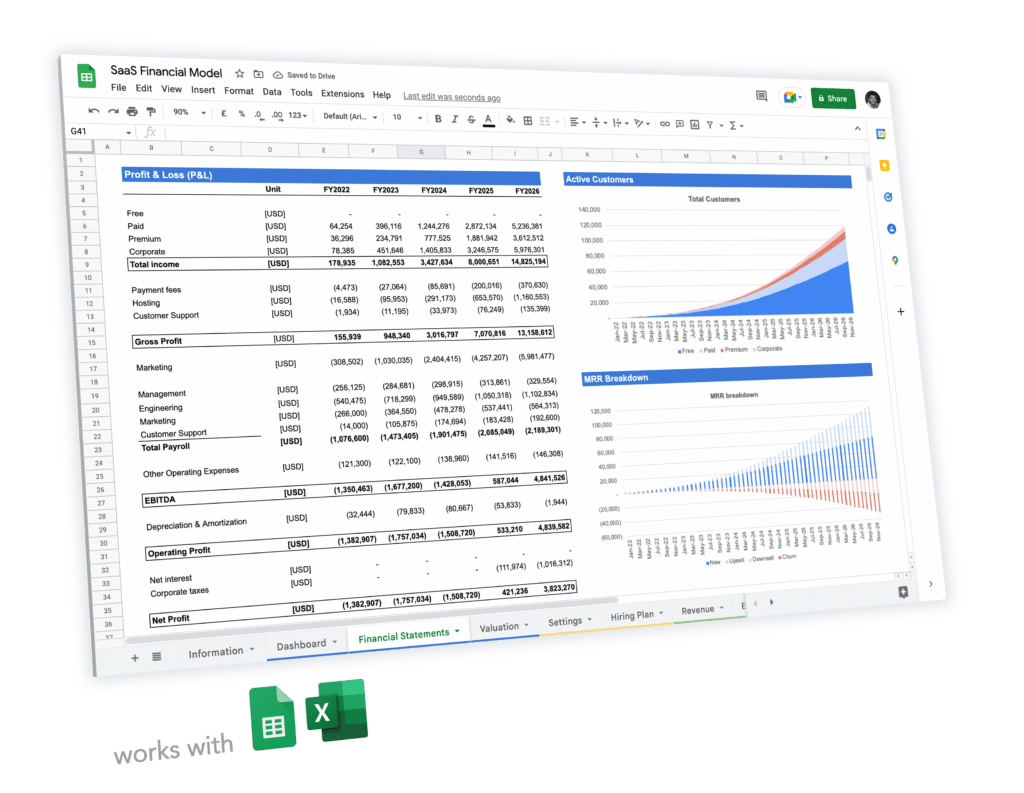Startup Financial Forecasting: How Far Ahead Should You Forecast?

When it comes to predicting the future, forecasting your startup financial performance is always challenging. Yet, forecasting near-term future being easier than long-term, entrepreneurs often ask us how far ahead they should prepare their financial forecasts.
The answer, as you would have guessed it, depends on the objective of the financial forecasts. Whilst forecasting 5-year is often the most appropriate, 3-year or even shorter financial forecasts work very well in certain cases.
In this article we will cover:
- What is the difference between forecasting and budgeting for startups?
- Startup financial forecasting: how far ahead should you forecast?
Forecasting vs. budgeting for startups
You might have used both terms interchangeably yet they are very different terms in finance.
Financial forecasting
In short, financial forecasting is used by businesses to estimate financial performance over a given period, often longer than a year. For existing businesses, financial forecast is based on current historical performance and tries to forecast where the business will be in the next 2, 3 or 5 years.
For new businesses, such as early stage startups, financial forecasting is not based on historical performance. Yet, it still try to depict where the business will be in the next few years. The exercise is of course much more or a guess as there is no historical performance to support assumptions.
Also, financial forecasts are often updated based on changes of circumstances: a drop in conversion rates, an increase in salaries expenses (after you hired a new employee), etc.
Budgeting
Budgeting, in comparison, is an objective. It’s a representation of a business’ financial performance where the management wants it to be in the future. Unlike financial forecasts, budgets are almost exclusively 12 months financial projections.
Usually, companies prepare their budget for the next fiscal year, broken down in quarters for instance. Unlike financial forecasts, the budget is then keep as is for the rest of the period (the fiscal year here).
Indeed, you should consider budgets as a target, which we refer to when we want to compare our actual performance vs. the budget we had prepared back then.
Businesses update their budgets on very rare occasions, often due to unexpected events having large impact(s) on financial performance. An obvious example is Covid-19 which forced almost all businesses to revise their annual budgets.
How far ahead should you forecast?
Now that we have shed some light on the difference between budgeting and financial forecasting, let’s see how many years ahead you should forecast your startup.
As explained earlier, with financial forecasting we try to estimate where a startup’s financial performance will be in the future. The number of years (or months) we forecast depends on the objective of the forecasts, yet usually ranges from 3 to 5 years.
In doubt, prepare 5-year financial forecasts
As rule of thumb, if you are preparing financial forecasts to obtain funding (equity or debt), prepare a 5-year forecast. Indeed, lenders and investors alike will often require a 5 year financial plan for their own purposes.
Banks typically use 5-year forecasts to assess credit risks for regulatory purposes. Investors (venture capital firms, angel investors, etc.) are more flexible as they don’t have the same regulatory requirements. Yet investors often require 5-year forecasts to estimate their own returns.
There is another good reason why startups often prepare 5-year financial forecasts: startups often are loss-making in the first years of operations. Hence a 3-year forecast might not be very attractive as they might still be loss making by that time, or be barely profitable. This wouldn’t look very attractive for investors.
Exceptions to the 5-year rule
There are cases where 5-year isn’t required though. This is good news: even for established businesses, forecasting 5 years ahead is likely not to be fully accurate. This is especially true for startups. Because long term projections always have some margin of error, why should you forecast 5 years when you can do less?
Early stage startups, from pre-seed to seed, can often rely on 3-year forecasts instead. Indeed, no one really knows where these businesses will be in 5 years, so forecasting well ahead is irrelevant. Instead, investors prefer having well though 3 years projections, which also come with their level of uncertainty of course.
What if you aren’t profitable in 3 years? Don’t worry, pre-seed and seed investors don’t necessarily look for businesses turning profits early on. Instead, they look for businesses with strong growth potential.
What if you aren’t fundraising?
Another exception is when you prepare financial forecasts for your own purposes. Keeping an updated financial forecast is indeed vital for startups. There are many examples where startup financial forecasting is very useful, among others when you are trying to:
- Assess how many hires you can do in the next 12 months
- Estimate your cash burn and runway following a change of events to time your next fundraising
- You want to know how much you can spend in marketing acquisition
When financial forecasts are used for your own business decisions instead of raising capital, use the relevant time period you are looking at. For instance, if you want to time your next fundraising, forecasting 2 years ahead only might be just enough.
Still, because you update the same financial forecast over and over again, we recommend keeping an updated 3-year financial forecast at all times. Even if you are trying to assess the number of hires you can afford until your next fundraising in 12 months, you won’t just created another separate forecast for that. Instead, update your 3-year forecast, and look at the next 12 months for your analysis.


 5-year pro forma financial model
5-year pro forma financial model 20+ charts and business valuation
20+ charts and business valuation  Free support
Free support